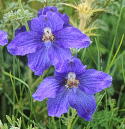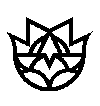Flora of China
Flora of China News

The Flora of China Newsletter is intended to inform the worldwide
botanical community about progress made on the Flora, as well as on related botanical activities in China.
Volumes
Net Connections
- Flora of China Volume 20-21 (Asteraceae) was published online on 25 October 2011;
the volume was published in traditional printed form on 11 November 2011. It is the twenty-first
of the now 23 text volumes in the series, and treats 2336 species (1,145 endemic, 109 introduced) within 15 tribes and 248 genera of Asteraceae.
- Volume 19 was published on 28 February 2011, and treats the families
Cucurbitaceae, Rubiaceae, Acanthaceae, Carlemanniaceae, Lentibulariaceae,
Myoporaceae, Phrymaceae, Plantaginaceae, Sphenocleaceae, Campanulaceae, Pentaphragmataceae, Stylidiaceae, Goodeniaceae, Adoxaceae,
Diervillaceae, Caprifoliaceae, Linnaeaceae, Morinaceae, Dipsacaceae, Valerianaceae, plus Annonaceae and Berberidaceae.
- Volume 23 was published in September 2010, and treats the families Acoraceae,
Araceae, Lemnaceae, Alismataceae, Butomaceae, Hydrocharitaceae, Scheuchzeriaceae, Aponogetonaceae, Juncaginaceae, Zosteraceae, Potamogetonaceae,
Zannichelliaceae, Posidoniaceae, Ruppiaceae, Cymodoceaceae, Burmanniaceae, Triuridaceae, Pandanaceae, Corsiaceae, Arecaceae, Typhaceae, and Cyperaceae.
- Volume 10 (Fabaceae) was published in February 2010.
- Volume 25 (Orchidaceae) was published in September 2009.
- Volume 7 was published in December 2008, and treats
the Menispermaceae, Illiciaceae, Schisandraceae, Magnoliaceae, Calycanthaceae, Myristicaceae, Lauraceae,
Hernandiaceae, Papaveraceae, Cleomaceae, and Capparaceae.
- Volume 11 was published in April 2008, and treats
the Oxalidaceae, Geraniaceae, Biebersteiniaceae,
Tropaeolaceae, Linaceae, Erythroxylaceae, Zygophyllaceae, Rutaceae, Simaroubaceae, Burseraceae, Meliaceae,
Malpighiaceae, Polygalaceae, Dichapetalaceae, Euphorbiaceae, Pandaceae, Daphniphyllaceae, Callitrichaceae,
Buxaceae, Coriariaceae, Anacardiaceae, Aquifoliaceae, Plagiopteraceae, Cardiopteridaceae, Celastraceae,
Salvadoraceae, Staphyleaceae, Icacinaceae, Aceraceae, Dipentodontaceae, Nitrariaceae, Peganaceae,
Cneoraceae, Surianaceae, and Tapisciaceae.
- Volume 12 was published in November 2007, and treats
the Hippocastanaceae, Sapindaceae, Sabiaceae, Balsaminaceae, Rhamnaceae, Leeaceae, Vitaceae,
Elaeocarpaceae, Tiliaceae, Malvaceae, Bombacaceae, Sterculiaceae, Dilleniaceae, Actinidiaceae,
Ochnaceae, Sladeniaceae, Pentaphylacaceae, and Theaceae.
- Volume 13 was published in June 2007, and treats the
Clusiaceae, Dipterocarpaceae, Elatinaceae, Frankeniaceae, Tamaricaceae, Cistaceae, Bixaceae, Violaceae, Flacourtiaceae,
Stachyuraceae, Passifloraceae, Caricaceae, Tetramelaceae, Begoniaceae, Ancistrocladaceae, Cactaceae, Thymelaeaceae, Elaeagnaceae,
Lythraceae, Trapaceae, Crypteroniaceae, Lecythidaceae, Rhizophoraceae, Nyssaceae, Alangiaceae, Combretaceae, Myrtaceae, Melastomataceae,
Onagraceae, Haloragaceae, Hippuridaceae, Cynomoriaceae, and Araliaceae.
- Volume 22 was published in June 2006, and treats the Poaceae.
- Volume 14 was published in February 2005, and treats the families:
Apiaceae, Cornaceae, Aucubaceae, Helwingiaceae, Mastixiaceae, Toricelliaceae, Diapensiaceae, Clethraceae, and Ericaceae.
- Volume 5 was published in December 2003, and treats the families:
Ulmaceae, Rhoipteleaceae, Moracae, Cannabaceae, Urticaceae, Podostemonaceae, Proteaceae,
Santalaceae, Olacaceae, Opiliaceae, Loranthaceae, Viscaceae, Rafflesiaceae, Balanophoraceae,
Aristolochiaceae, Polygonaceae, Chenopodiaceae, Amaranthaceae, Nyctaginaceae, Phytolaccaceae,
Aizoaceae, Molluginaceae, Portulacaceae, and Basellaceae.
- Volume 9 was published in May 2003, and treats the families:
Pittosporaceae, Hamamelidaceae, Eucommiaceae, Platanaceae,
Rosaceae, and Connaraceae.
- Volume 6 was published in December 2001,
and treats the families: Caryophyllaceae, Nelumbonaceae, Nymphaeaceae,
Cabombaceae, Ceratophyllaceae, Eupteleaceae,
Trochodendraceae, Tetracentraceae, Cercidiphyllaceae,
Paeoniaceae, Ranunculaceae,
Circaeasteraceae, and Lardizabalaceae.
- Volume 8 was published in June 2001,
and treats the families: Brassicaceae, Resedaceae,
Moringaceae, Bretschneideraceae, Nepenthaceae, Droseraceae,
Crassulaceae, and Saxifragaceae.
- Volume 24 was published in 2000, and
treats the families:
Flagellariaceae,
Restionaceae,
Centrolepidaceae,
Xyridaceae,
Eriocaulaceae,
Bromeliaceae,
Commelinaceae,
Pontederiaceae,
Philydraceae,
Juncaceae,
Stemonaceae,
Liliaceae,
Amaryllidaceae,
Taccaceae,
Dioscoreaceae,
Iridaceae,
Musaceae,
Lowiaceae,
Costaceae,
Zingiberaceae,
Cannaceae,
and Marantaceae.
-
Volume 4 was published in 1999, and
treats the families:
Cycadaceae,
Ginkgoaceae,
Araucariaceae,
Pinaceae,
Sciadopityaceae,
Taxodiaceae,
Cupressaceae,
Podocarpaceae,
Cephalotaxaceae,
Taxaceae,
Ephedraceae,
Gnetaceae,
Casuarinaceae,
Saururaceae,
Piperaceae,
Chloranthaceae,
Salicaceae,
Myricaceae,
Juglandaceae,
Betulaceae, and
Fagaceae.
- Volume 18 was published in 1998 and treats the families:
Scrophulariaceae,
Bignoniaceae,
Pedaliaceae,
Martyniaceae,
Orobanchaceae,
and Gesneriaceae.
- Volume 15 was published in 1996 and treats the families:
Myrsinaceae,
Primulaceae, Plumbaginaceae,
Sapotaceae,
Ebenaceae,
Symplocaceae,
Styracaceae,
Oleaceae, and
Loganiaceae.
- Volume 16 was published in 1995 and treats the families
Gentianaceae,
Menyanthaceae,
Apocynaceae,
Asclepiadaceae,
Convolvulaceae,
Polemoniaceae,
Hydrophyllaceae, and
Boraginaceae.
- Volume 17 was published in 1994 and treats the families
Verbenaceae,
Lamiaceae, and
Solanaceae.
Flora of China Illustrations
Volume 19-I was published in March 2012,
Volume 23-I in 2011,
Volumes 10-I and 25-I in 2010.
Volumes 7-I and 11-I in 2009,
13-I and 12-I in 2008,
22-I in 2007,
14-I in 2006,
5-I in 2005,
9-I in 2004,
6-I and 8-I in 2003,
24-I in 2002,
4-I in 2001,
18-I in 2000,
15-I in 1999,
16-I in 1999, and
17-I in 1998.
To order or to request any information regarding the volumes, please contact:
Missouri Botanical Garden Press
Related articles are available online; see papers published in Novon and
Harvard Papers in Botany.
The Flora of China Checklist will include accepted botanical names, synonyms, and their bibliographical citations;
reference to the volume, page, and year in which the taxon was treated in the Flora of China and
Fl. Reipublicae Popularis Sin.;
distribution in China (at the provincial level) and in areas neighboring China;
altitudinal ranges;
and status (whether the taxon is endemic, indigenous, naturalized, or cultivated in China).
Full cross-references of accepted names and synonyms will be given.
The checklist is part of the major database of Missouri Botanical Garden, which will include additional information on type specimens, chromosome numbers, and other relevant data.
An HTML interface to the Checklist is available.
The web interface creates lists of accepted names and new taxa.
 The Harvard University Herbaria, one of the editorial centers for the Flora of China Project,
is the site for the Flora of China Web.
The web pages contain this regularly updated newsletter, introductory information,
an alphabetical index to families,
floristic treatments (eFloras),
interactive keys for identification,
related papers,
images,
links to the FOC illustrations,
and information on editorial centers and the people involved in the Project.
Web-based interactive identification keys to large and medium-sized genera of the flora of China are available
in DELTA Intkey and NaviKey formats.
NaviKey is a Java applet for accessing DELTA data using any web browser.
The keys are also accessible via PathKey (for any browser or mobile device).
The Harvard University Herbaria, one of the editorial centers for the Flora of China Project,
is the site for the Flora of China Web.
The web pages contain this regularly updated newsletter, introductory information,
an alphabetical index to families,
floristic treatments (eFloras),
interactive keys for identification,
related papers,
images,
links to the FOC illustrations,
and information on editorial centers and the people involved in the Project.
Web-based interactive identification keys to large and medium-sized genera of the flora of China are available
in DELTA Intkey and NaviKey formats.
NaviKey is a Java applet for accessing DELTA data using any web browser.
The keys are also accessible via PathKey (for any browser or mobile device).
Support has been provided by grants from the U.S. National Science Foundation, the Starr Foundation, Fondation Franklinia, and the Stanley Smith Horticultural Trust.
 Back to Home Page
Back to Home Page
 Back to Home Page
Back to Home Page
 The Harvard University Herbaria, one of the editorial centers for the Flora of China Project,
is the site for the Flora of China Web.
The web pages contain this regularly updated newsletter, introductory information,
an alphabetical index to families,
floristic treatments (eFloras),
interactive keys for identification,
related papers,
images,
links to the FOC illustrations,
and information on editorial centers and the people involved in the Project.
The Harvard University Herbaria, one of the editorial centers for the Flora of China Project,
is the site for the Flora of China Web.
The web pages contain this regularly updated newsletter, introductory information,
an alphabetical index to families,
floristic treatments (eFloras),
interactive keys for identification,
related papers,
images,
links to the FOC illustrations,
and information on editorial centers and the people involved in the Project.